Once you have tasted biltong, you’ll be a fan of this spiced dried meat that South Africans have made famous around the world. As with jerky, biltong making arose out of necessity.
In the early days, when there were no fridges to store fresh meat, and once a steer had been slaughtered or an antelope had been shot, people had to preserve the meat by air drying it.
Biltong is a type of dried meat typically made from beef, but also from game meat such as venison, ostrich, kudu, and eland (to name a few). Biltong is not sweet or rubbery like jerky…
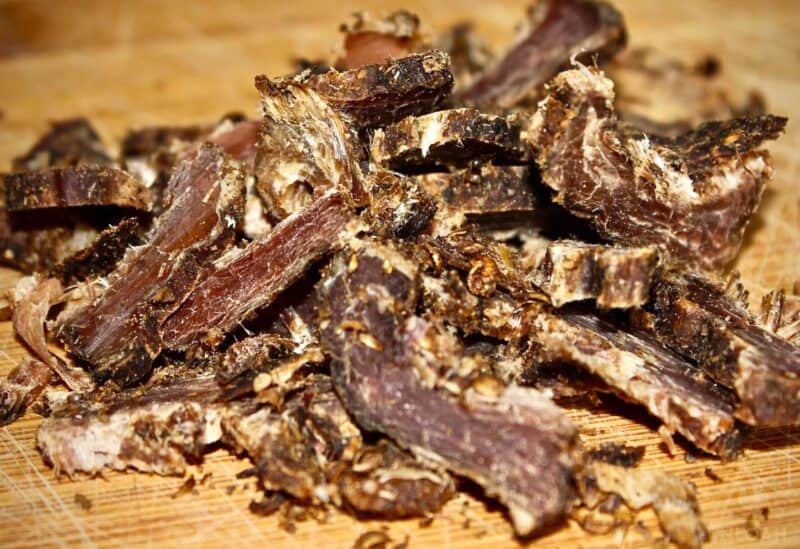
We, South Africans, save the sweetness for desserts and we do have some super-sweet ones like koeksisters – something like a doughnut that’s plaited, deep fried, then dunked in a cold lemony syrup; or malva pudding – a soft pudding that’s given a sauce that soaks through made from cream, butter, and sugar.
Sugar on our meat is not popular among biltong fans…
Adding sugar – brown sugar, for example – may sweeten the taste but it also brings you closer to beef jerky than to South African biltong.
It’s all about the unique spice mix and salt and enjoying this snack with a cold lager. Biltong – pronounced bill-tong is air dried, and although you can use a dehydrator, most South Africans use a biltong box, as it makes drying the meat easier and more hygienic.
However living in South Africa most of my life, I have seen people dry it in garages with the meat hung on lines, and a fan going to keep any insects off and make sure the drying progresses evenly.
People who visit South Africa and are introduced to biltong always want to take some back to their home countries – whether it is Scandinavia, France, Italy, or the UK – just as long as they can get meat products through customs.
Some visitors even buy the biltong box kits when they visit, which they can assemble at home. When you have mastered the art of making biltong you will have plenty of friends flocking around to enjoy big games with a couple of drinks and the platter of biltong being passed around.
Origins
The word ‘biltong’ comes from the combination of the Dutch words ‘bil’ – which means buttock and ‘tong’ which means tongue or strip.
Back in the days when refrigerators weren’t a thing, the pioneers needed a way to preserve their meat. They did this either by curing or dehydrating their meat.
Biltong was typically made out of whatever a hunter could catch as that was what was available. It was also typically made in the winter months when the colder temperatures would reduce the risk of mold.
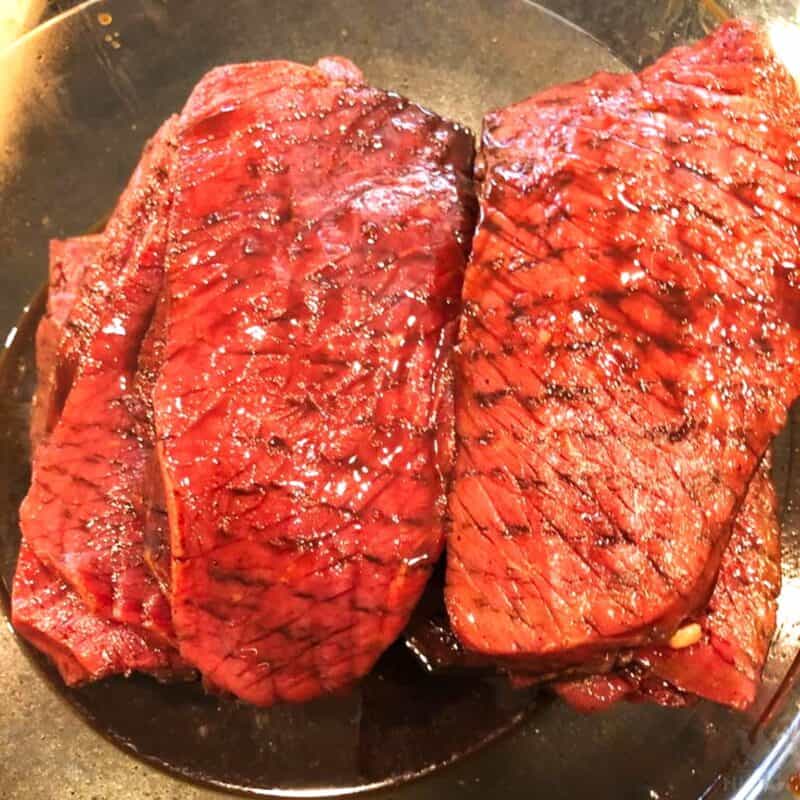
Best Beef to Use for Biltong
For this recipe we will be using beef as anyone can get their hands on some at the local butcher or supermarket.
Once you have the art of making biltong honed, then maybe you want to start using some of the meat from hunting expeditions. Biltong made from beef or venison is the most popular. If you like quite a dry biltong then the venison is really good.
Try to avoid fatty cuts of beef as it is trickier to dry fatty meat without it spoiling. For biltong making it is not worth buying super expensive meat as you should rather grill your top quality cuts, like fillet steak.
You need to find the balance between quality and cost because in the drying process, you’re going to lose some of the weight, and then per pound biltong can work out quite expensive – but it is so worth it!
Once you have your chosen cut – probably silverside or topside, remove some of the excess fat. Some people like their biltong lean without any fat and some prefer the added flavor of a bit of fat on the biltong – it’s up to you – but you have to be more careful to ensure that the fat is properly dried.
Also, remove any gristle or sinew which once it is dried is pretty much inedible and you don’t want that ruining your biltong snack.
How to Dry Biltong
You can air dry the biltong, but it will take longer and you need the right weather, whereas a commercial biltong maker or dehydrator will have a built-in fan for continuous airflow to speed up the process, as well as a light fitting which will prevent the growth of mold, and also help reduce moisture.
There are air-drying nets available, so if you don’t have an electric dryer you may simply want to hang the meat up with a fan directed toward the meat.
Try to make biltong in the dry and cooler seasons of the year, as humid conditions can lead to meat spoilage. It’s important to know that biltong is not smoked meat – it is air-dried.
Careful About Mold
Never, ever eat any biltong that has mold growing on it! A friend’s husband thought if he cut the little moldy section off a piece of biltong he’d left in the refrigerator for a while it would be fine. His wife refused to have any.
Later that night, he was vomiting, and had diarrhea so badly he collapsed – his wife had to call the ambulance and he was rushed to hospital and placed in intensive care, only to be released from the hospital ten days later.
Mold can look like it’s only on the surface but often the threads in the mold may have penetrated the food to a deeper level.
Every experienced biltong maker has a personal recipe for making biltong. The biltong in these pictures was made by an ex-South African / Zimbabwean couple living in Phoenix, Arizona, who missed their favorite snack in the US, and have perfected their way of doing it which I am going to share with you.
You can substitute the cumin in this recipe for paprika, and add in some dried chili if you prefer a spicier biltong, but the spices used here are the more traditional ones.
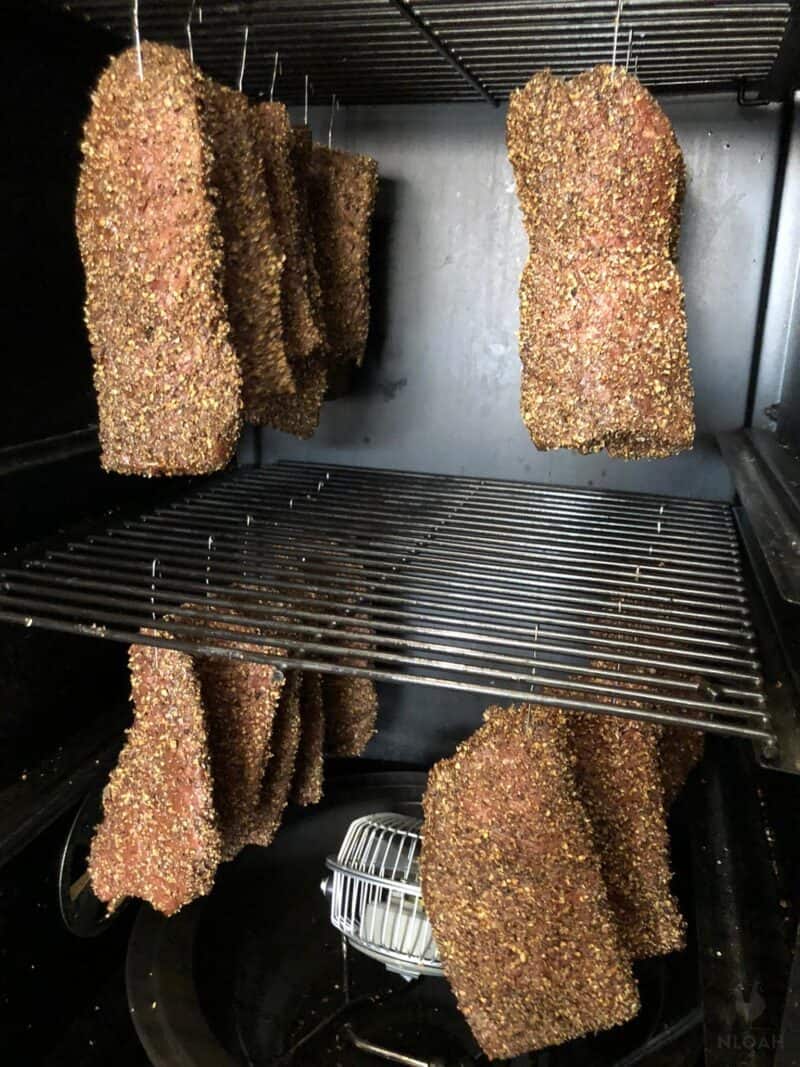
How Long Should I Dry the Meat?
It all depends on the type of dryer and thickness of the meat as to how soon your meat is ready. If you are hanging the meat in a room with a fan it may take up to 10 days to dry.
You need a coolish temperature (less than 86 F / 30 C), and sufficient airflow for the best quality biltong. The idea is to retain the flavor of the beef by removing the majority of the moisture evenly. If the airflow is too strong, it will dry the outside of the meat, and the inside won’t cure properly.
Authentic Biltong Recipe
Ingredients
- 4 lbs. beef silverside or topside
- 4 tablespoons salt
- 8 tablespoons coriander
- 4 tablespoons black peppercorns
- 1 tablespoon ground cumin optional
- 10 ounces balsamic vinegar
- Worcestershire sauce
Instructions
- Cut the meat along the grain into strips roughly ½ an inch thick and around 8 to 10 inches long.
- Place the meat in a mixture of salt, Worcestershire sauce and balsamic vinegar making sure each part of the meat is moistened in the mix – you can set the meat aside to marinade in the fridge for between half an hour to an hour.
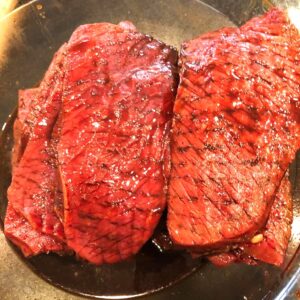
- Once you’ve got the coriander seeds ground, coarsely grind your black peppercorns and add them to the mix. Try to avoid grinding the peppercorns too fine if you want the best flavor.
- Mix the coriander, black pepper, ground cumin, and salt. (Photo by V. Edgar)
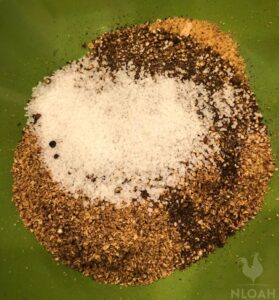
- Remove the meat from the vinegar/Worcestershire sauce mix, pat it, dry with a clean kitchen cloth, and then coat it evenly with spices. As each piece is covered in spice, set it aside in a dish until you are ready to hang it up to dry.
- Hang the meat up in your dryer.
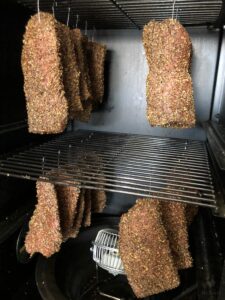
- Leave the meat to dry for between 24 hours to 4 days in the biltong maker, and close to a day if using a dehydrator. It all depends on the type of dryer and thickness of the meat as to how soon your meat is ready. If you are hanging the meat in a room with a fan it may take up to 10 days to dry.
Notes
- The point of using the vinegar is to make sure any bacteria are neutralized.
- The Worcestershire sauce just adds depth of flavor to the biltong. You can use red wine vinegar rather than balsamic vinegar if you prefer.
- The length of the strips will depend on the height of your dryer as the meat must not touch the tray at the bottom.
- The point of using vinegar is to neutralize any bacteria that may affect the meat. The Worcestershire sauce just adds depth of flavor to the biltong. You can use red wine instead of vinegar if you’d prefer.
- Some people soak their meat in salt first, then rinse off the salt before placing it in vinegar, but it can make the meat very salty. So, many omit the salt soak and add the salt to the spice mix instead. Salt is essential to let the meat dry and cure properly.
When it comes to slicing biltong remember that it is quite tough, and the knife can slip easily. Most South Africans have a biltong slicer, which makes the job easier.
South Africans can get fussy about the way it is sliced too – so bringing out the slicer and cutting according to guest preferences also makes something of a talking point at a gathering!
Storage
Be careful when drying and storing your biltong so that it does not spoil. Freezing is a good option as it can last for up to 12 months in a freezer, but will last a few days in the fridge in a paper bag or in a glass jar.
It will last longer if it is vacuum sealed. Biltong is such a delicious snack you may not be able to keep it away from the family and visitors long enough to have to worry about preserving it – alter all you can always make more!
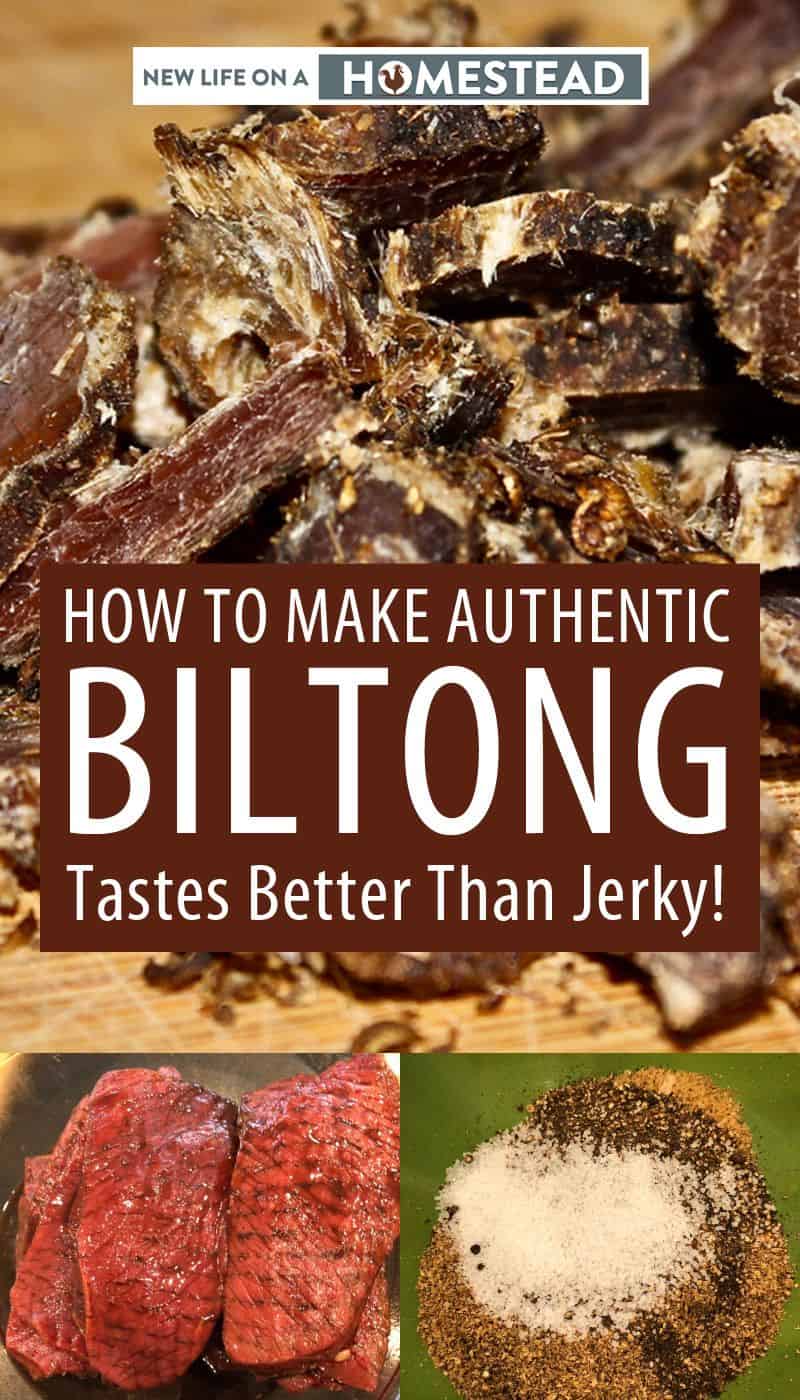
After a couple of university degrees, a teaching career in Art Education and English, a few years in journalism, the modelling and fashion industry, and a family followed. Then, one day when marking about the 256th essay during exam time, I decided – Enough! I’ll do my own writing instead, and have never looked back. Travel writing, recipe development as well as writing about homesteading, camping, and children keep me busy. Holidays and weekends have been spent in the great outdoors, hiking, fishing and diving all around the world. Learning tricks from other cultures on planting and gardening brought new ideas to food gardens and creating beautiful outdoor spaces. And everywhere I go my camera goes too – so many of the articles are illustrated with my own photos.

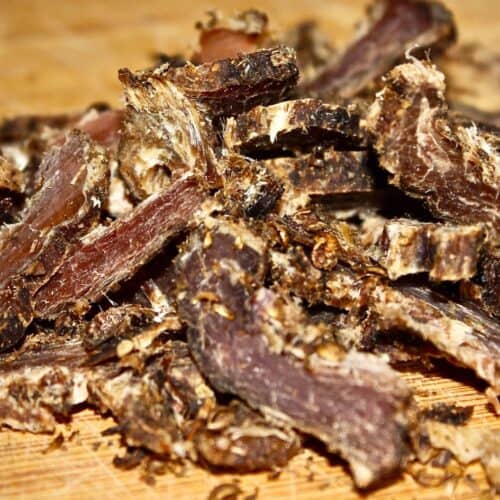
Hi everyone
I think a lot of confusion is being created by saying you make it in the winter.
I live in Ca and winter is when we get our rainfall and humidity is high. In s Africa you get your rain in the summer the same as our Midwest does.
I make mine in the summer here in Ca.
Hope that helps.
I once stayed with some South Africans and they just had it hanging in a spare room.
Can I dry it in my gas stove with just the pilot light? Special instructions? How long to cure?
I’m still on the learning curve with biltong but this recipe is giving me the best results. I’ve been using malt vinegar.
Could you use a freeze dryer to make this?
As a bit of a prepper, I have been making beef and venison jerky for more than a decade. Now I am going to expand to Biltong…had my first taste and loved it.
So, my plan is to use the standard dehydrator. Will that work ok?
Geez people , biltong is air cured meat. Not dehydrated. Even putting it in a biltong box is not traditional, as the flavor wont have time to develop.
Hanging and curing naturally in 10-14 days is best, this is why the snack is typically made in the winter where the air is cool and the humidity low.
These commercial quick dry solutions wont taste the same
Dehydrator works just fine
Not a problem the difference between jerky and BIltong is its more traditional and more like the original settlers and natives of America. I don’t think a modern dehydrator cuts it. go old school.look up south African biltong. and if you get a little mould wash with vinegar and it is fine. I keep mine forever in a freezer vacuum sealed.
Never come across biltong done with balsamic vinegar before. Certainly would disqualify it as “authentic “. Brown malt vinegar is traditional. Been making and munching the stuff for years.
You are right. Brown vinegar is more traditional.
White spirit vinegar is traditional (made from grape must). With an acidity of at least 10%. (Non aged). The brown vinegar in South Africa typically has a bit of brown sugar in it
Malt vinegar is what is used in foreign countries perhaps where they cannot find Spirit vinegar. But have never seen anyone in south africa use this.
Also dont use balsamic as this will alter the taste
Can u give me tips on using an airfryer, I have one that goes down to 90F on dehydrate mode and got some in there now as a tester but open to any tips.
Biltong is best done at around 21’C .Air dried Mongolian beef use a higher temp to dry with heat . it needs much thinner cuts, no more than 1cm. The air fryer will give a harder dryer piece of meat in 4 to 6 hours
Biltong is air cured, not cooked, not dehydrated. Please don’t rely on heat. Rely on airflow.
Worst case build or buy a biltong box.
There is a dedicated a very important ingredient missing in the above recipe. And that is saltpeter. This is especially necessary in countries /areas with high humidity to prevent mould and spoilage
There is a reddit r/biltong for any questions and recipes you may have.
Saltpeter? No thank you